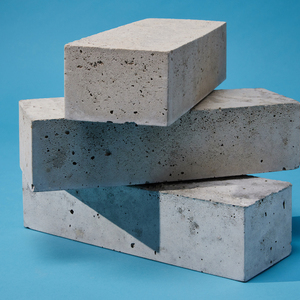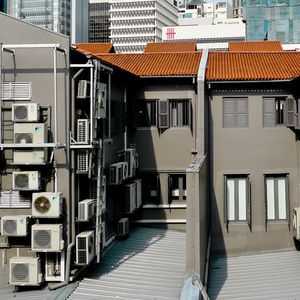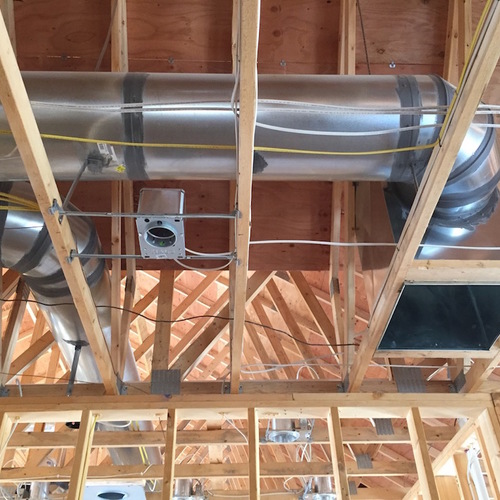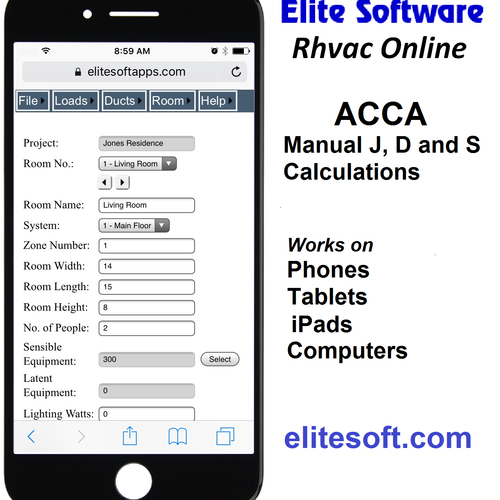
Image Credit: Energy Vanguard
What if a builder refused to build from plans drawn by an architect? What if a tile installer refused to implement designs handed to them and instead did their own thing? What if an HVAC contractor told a potential client they wouldn’t install a system designed by a third party to ACCA protocols?
One of those questions is more real than the others. Of course builders build from architects’ plans and tile installers don’t throw out designs they’re asked to implement. But third-party HVAC design is a different animal.
The benefits of using a third party for HVAC design
We do third-party residential HVAC design at Energy Vanguard. Andy Bell runs that part of the company and is a true master of the art and science of heating and cooling load calculations (ACCA Manual J), equipment selection (Manual S), register and grille selection (Manual T), and duct design (Manual D). That’s pretty much all he does these days.
Our clients are architects, HVAC contractors, home builders, owner-builders, and homeowners having their dream home built. When they hire us, they do so for several reasons. They want:
- Their system sized using load calculations rather than rules of thumb;
- Help deciding among a broader set of options than most contractors offer (e.g., conventional equipment, minisplit heat pumps, ductless, ducted);
- The design done by a company that doesn’t make money off the sale of the equipment.
We’re one of a pretty small group of companies that do third-party design and an even smaller number that does it remotely. Mostly what happens is that HVAC contractors make the decisions about what equipment to install, what size it will be, and how to get the heating and cooling distributed. Sometimes they do actual design, using the protocols of the Air Conditioning Contractors of America (ACCA). Mostly they use other methods, oftentimes rules of thumb.
The problem with rules of thumb is that they’re unreliable. Using the industry standard ACCA protocols, when they’re done accurately, doesn’t mean there’s zero chance of problems, but it gives you the best shot of designing a system that will work. We’ve done hundreds and have had only a handful of former clients come back to us with problems. In those cases, we’ve been able to help them figure out what’s going on and how to get the problem fixed.
The (occasional) difficulties of third-party HVAC design
Sometimes we have a different kind of problem. We usually work remotely and never see our clients. They hire us. We provide the HVAC design documents. They use those documents to hire a contractor (in the cases where they don’t already have one). And that’s where things can fall apart.
One thing that happens is the client provides our design documents to a contractor, who says, “I’m not going to install that. I didn’t design it.” Or worse, they take a look, see what size we’ve specified for the air conditioner, do a quick calculation in their head using a rule of thumb, and say, “This design is wrong. It won’t cool your house. You wasted your money hiring them, and I’m not installing that.”
Most of the time we’re able to work with the client and the HVAC contractor to overcome those initial objections. Occasionally, though, every single contractor the client talks to is dead set against using our design. And because they meet with the client face-to-face and we’re only a voice on the phone, the contractors have extra sway.
The contractor’s fear
Going back to those initial questions I asked, builders don’t have a problem building from an architect’s plans and tile installers don’t have a problem implementing the designs of others. But HVAC contractors aren’t used to being told what size equipment to install and how to run the ducts. And they have legitimate fears.
If the equipment sizing and duct design are significantly different than what they’re used to installing, they’re afraid it won’t work. When that job is finished and people are living in the house, who are they going to call if the system doesn’t work? Well, the first call probably goes to the builder. Then the HVAC contractor. Then the third-party HVAC designer, if the previous two calls didn’t get the desired results.
So the HVAC contractor is ahead of us in the accountability line. They look at a design that’s different from what they’re used to installing, and that extra accountability is what scares them.
How do we fix this?
I’m not writing this to throw HVAC contractors under the bus. Yeah, there’s plenty of bad workmanship and uneducated contractors out there, but the HVAC industry needs a revolution. Contractors have three big areas of responsibility when they get a job:
- Design
- Equipment
- Distribution
I’d say the only one they do OK on is equipment. Yes, there are contractors who do all three well, but they’re in the minority. The majority of contractors skip over design and do a pretty bad job on the distribution side. I’ve written plenty about the distribution side in this blog. Today my focus is design.
My hope is to have a relationship between third-party HVAC designers and HVAC contractors like that between architects and builders. Architects and builders are both licensed professionals, so one part of the answer may be to require licensing for third-party designers. I’m not convinced that would solve the problems, though. If licensing were the answer, the contractors — who have to be licensed in most places — would already be doing everything properly. And my friend Kristof Irwin of Positive Energy in Austin, Texas is a licensed engineer who faces the same kinds of problems.
My crystal ball is a bit foggy right now, and I can’t see where this ends up. Maybe the answer is time. As third-party HVAC design becomes more common, the difficulties should diminish. Maybe it’s educated home buyers. I’m doing my part here to help with that. Maybe it’s something structural, like licensing. I don’t know.
What do you think?
Allison Bailes of Decatur, Georgia, is a speaker, writer, building science consultant, and the author of the Energy Vanguard Blog. You can follow him on Twitter at @EnergyVanguard.
Weekly Newsletter
Get building science and energy efficiency advice, plus special offers, in your inbox.















5 Comments
An industry in crisis
Allison,
Thanks for this article. As I've noted before, the residential HVAC industry (if you can even call it an industry) is in a state of crisis.
I addressed the issue in a recent article, "Fixing Energy Star Version 3." Under the heading "An industry in a perpetual state of crisis," I wrote:
"The known scarcity of skilled HVAC contractors leads to an obvious question: What’s wrong with the residential HVAC industry? It’s hard to say. On a typical residential construction site, the framers, on average, are doing an excellent job. Framers work from good plans and execute the plans well. Framing failures are very rare.
"Electricians and plumbers are also doing excellent work. Residential electrical system design and residential plumbing system design are both excellent, and these systems are installed well.
"So what’s wrong with residential HVAC work? Why are contractors doing such a lousy job?
"The failures can be partly blamed on equipment manufacturers, since manufacturers are doing a terrible job of training contractors.
"The failures can be partly blamed on regulators, since regulators are doing a terrible job of certifying contractors.
And the failures can be partly blamed on code officials, since code officials are doing a terrible job of enforcing existing codes."
HVAC Design
Up here in Canada, where we do everything right, most jurisdictions now require the HVAC design to be completed by a designer registered with the Ministry of Housing. So, the practice of third party design is much more accepted among contractors. That said, it's not without problems. I haven't had any contractors complain about my duct designs, but I have had the occasional case where the contractor wanted to oversize equipment.
If the client is the builder or homeowner (i.e. not the HVAC contractor), I always ask who the HVAC contractor will be. I feel it's necessary to discuss the system with the HVAC contractor before I design it so that I know what brand and product line of furnace they plan to put in. That way, I have real blower data with which to design the ducts. But this also establishes a relationship between me and the contractor so that he knows I'm not just some egghead in an office somewhere. With open lines of communication, the contractor can also request minor changes to the design when he sees the plans or when he's on site and discovers something that is unworkable.
Follow the money?
Great summary to start an important conversation. I live in a house that was built using "rules of thumb" a while ago, so I have first-person experience with crappy HVAC design. I hope to find a good local (NorCal) HVAC designer for my upcoming build, and if not I'll reach back out to this community.
Question: what should a design cost for, say, a typical 2,500 sf house built to code minimum? Don't most HVAC contractors bundle system design into the system cost? If so, that's would explain a) why the quality of the work is low and b) the fear they'll be held accountable for 3rd party designs for work they have not been paid to do. Oversized systems cost more and generate more gross margin $'s if not %.
If good design costs thousands of dollars, and rules of thumb are free (with tacit manufacturer endorsement) ... ducts will go wherever there's room, and furnaces will be over-sized.
HVAC woes
This write up couldn't have come at a more appropriate time. This is exactly the problem we as a custom builder have been facing now for a couple of years, more so since we started concentrating on ZERO ENERGY HOMES. My regular HVAC Contractor would not agree to 3rd party plans or give us his J manual calculations to cross-check. Unfortunately, there is a large scarcity of trained HVAC companies and the demand is huge so they did not blink an eye to turn down 3-4 projects worth more than 150K in revenues.!! Another company wanted us to sign off a disclaimer that they would not be responsible if the homeowners complain of low cooling !! These companies don't even ask us questions like what kind of Insulation, any extra tight sealing for air barriers in place or what kind of windows we are using etc., They simply refuse to take into account these extra efforts we take to make the house more air-tight or the fact that we are aiming at less than 2ACH.
What could be the solution ? Its pretty vague..Maybe stricter code controls and insisting on J Manuals to release permits may help ?
As a builder in Ontario, we are required to provide heat loss calculations when applying for a building permit. I have never seen an actual duct design with that though, at least on our projects to date. Typically our HVAC contractors decide on the fly how and where they want to run duct. Now that we are trying to incorporate more of these conversations during the design process I’m hopeful that our HVAC contractors will be open to working with third party design. It also seems strange to me that excavation, foundation, framing, plumbing, electrical, gas and insulation all have mandatory inspection yet HVAC has nothing.
Log in or create an account to post a comment.
Sign up Log in